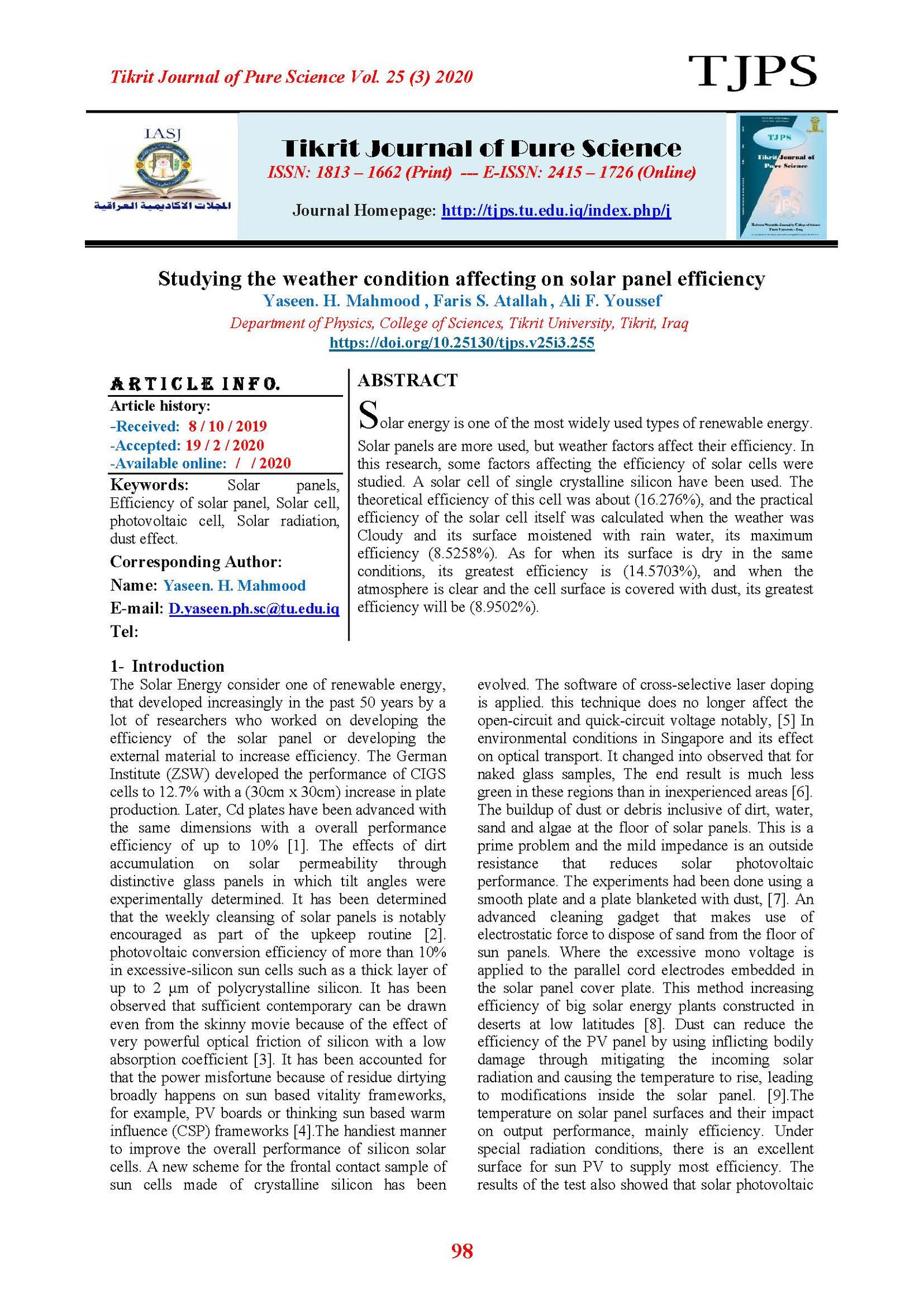Studying the weather condition affecting on solar panel efficiency
Main Article Content
Abstract
Solar energy is one of the most widely used types of renewable energy. Solar panels are more used, but weather factors affect their efficiency. In this research, some factors affecting the efficiency of solar cells were studied. A solar cell of single crystalline silicon have been used. The theoretical efficiency of this cell was about (16.276%), and the practical efficiency of the solar cell itself was calculated when the weather was Cloudy and its surface moistened with rain water, its maximum efficiency (8.5258%). As for when its surface is dry in the same conditions, its greatest efficiency is (14.5703%), and when the atmosphere is clear and the cell surface is covered with dust, its greatest efficiency will be (8.9502%).
Article Details

This work is licensed under a Creative Commons Attribution 4.0 International License.
Tikrit Journal of Pure Science is licensed under the Creative Commons Attribution 4.0 International License, which allows users to copy, create extracts, abstracts, and new works from the article, alter and revise the article, and make commercial use of the article (including reuse and/or resale of the article by commercial entities), provided the user gives appropriate credit (with a link to the formal publication through the relevant DOI), provides a link to the license, indicates if changes were made, and the licensor is not represented as endorsing the use made of the work. The authors hold the copyright for their published work on the Tikrit J. Pure Sci. website, while Tikrit J. Pure Sci. is responsible for appreciate citation of their work, which is released under CC-BY-4.0, enabling the unrestricted use, distribution, and reproduction of an article in any medium, provided that the original work is properly cited.
References
[1] Powalla, M. and Dimmler, B. (2000). Scaling up issues of GIGS solar cells. thin solid Film, 361 (2000):540-546.
[2] Hegazy, A. A. (2001). Effect of dust accumulation on solar transmittance through glass covers of plate-type collectors. Renewable Energy, 22 (2001):525–540.
[3] Yamamoto, K. et al. (2004).A high efficiency thin film silicon solar cell and module. Solar Energy, 77(6): 939-949.
[4] Costa, S.C.; Diniz, A.C. and Kazmerski, L.L. (2016). Dust and soiling issues and impacts relating to solar energy systems. Energy Reviews. 63 (2016):33–61.
[5]Zhu,L.Q. et al. (2011).Improving the efficiency of crystalline silicon solar cells by an intersected selective laser doping. Solar Energy Materials and Solar Cells, 95(12): 3347-3351.
[6]Jia,Y.H. et al. (2012).The Effect of Dust on Transmission and Self-cleaning Property of Solar Panels, Energy Procedia, 15: 421-427.
[7] Shaharin ,A. S. et al. (2014).Influence of Dirt Accumulation on Performance of PV Panels. Energy Procedia, 50(2014): 50-56.
[8] Hiroyuki, K. and Takuya, S. (2015).Electrostatic cleaning system for removal of sand from solar panels. Journal of Electrostatics,73(2015): 65-70.
[9] Fardila, M.; Zaihidee, S. M.and Mehdi, S.m. (2016). Dust as an unalterable deteriorative factor affecting PV panel's efficiency: Why and how. Renewable and Sustainable Energy Reviews, 65: 1267-1278.
[10] Zhijun, P.; Mohammad, R.and Yiming, L.(2017). Cooled solar PV panels for output energy efficiency optimization . Energy Conversion and Management ,150 (2017) :949–955.
[11] Queisser, H.J. and Werner, J.H (1995). Principles and Technology of Photovoltaic Energy Conversion. Solid-State and Integrated Circuit Technology, 4(1995):146-150.
[12] Maruyama, T. and Shinyashiki, Y.(1998). Energy Conversion Efficiency of Solar Cells Coated with Fluorescent Coloring Agent. Solar Energy Materials & Solar Cells, 56(1):1-6.
[13] Nishihata, M.; Ishihara, Y. and Todaka, T. (2006). Presumption of Solar Power Generation Corresponding to the Change of Solar Spectrum, Photovoltaic Energy Conversion . Proceedings of the 2006 IEEE 4th World Conference, 2 May 2006 .p. 2168-2171.
[14] Mahmood, H.Y; IbrahIm, M.A. and jadan, A.O. (2017). Design and installation of (flower sun) a concentration dish and study its parameters. Tikrit Journal of Pure Science,22(11):83-85.
[15] Duncan, C.H; Willson , R.C. and Kendall, J.M. (1982). Latest rocket measurements of the solar constant. Sol Energy, 28 :385–390.
[16] Rossi, C. et al. (2013). Experimental and numerical results from hybrid retrofitted photovoltaic Panels, Energy Conversion and Management,76 (2013) :634–644.
[17] Overstraeten, V.R. and Mertens, R.P. (1986). Physics, Technology and Use of Photovoltaic. Adam Hilger Ltd, New York : 0-85274-487-0.
[18] Mejia, F; Kleissl. J and Bosch, L.(2014). The effect of dust on solar Photovoltaic systems. Energy Procedia ,49 ( 2014 ): 2370 – 2376
[19] Eliminir, H.K, et al. (2006). Effect of dust on the transparent cover of solar collectors. Energ Conver Manage, 47(2006):3192–3203.
